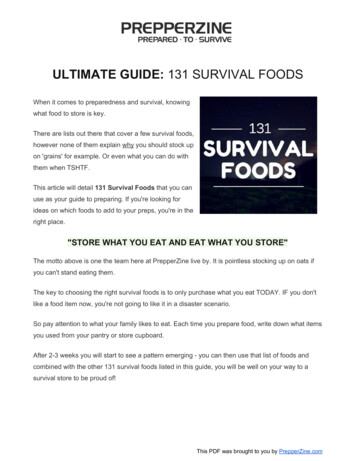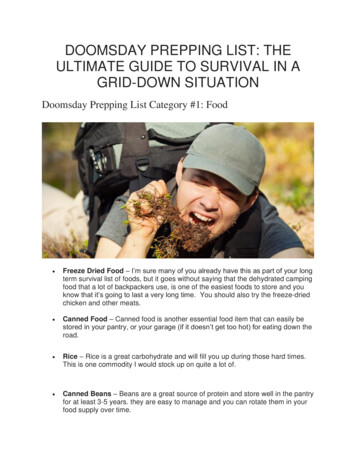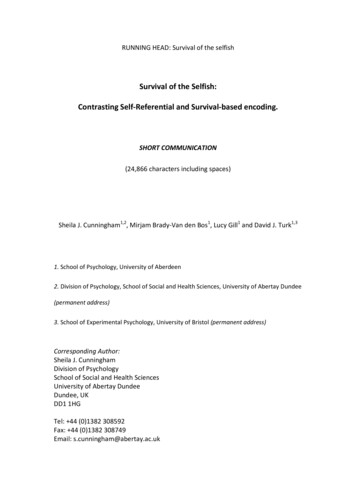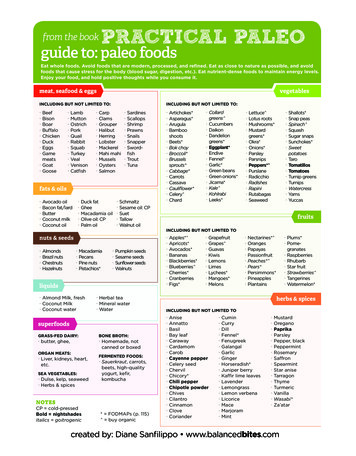
Transcription
ULTIMATE GUIDE: 131 SURVIVAL FOODSWhen it comes to preparedness and survival, knowingwhat food to store is key.There are lists out there that cover a few survival foods,however none of them explain why you should stock upon 'grains' for example . Or even what you can do withthem when TSHTF.This article will detail 131 Survival Foods that you canuse as your guide to preparing. If you're looking forideas on which foods to add to your preps, you're in theright place."STORE WHAT YOU EAT AND EAT WHAT YOU STORE"The motto above is one the team here at PrepperZine live by. It is pointless stocking up on oats ifyou can't stand eating them.The key to choosing the right survival foods is to only purchase what you eat TODAY. IF you don'tlike a food item now, you're not going to like it in a disaster scenario.So pay attention to what your family likes to eat. Each time you prepare food, write down what itemsyou used from your pantry or store cupboard.After 2 3 weeks you will start to see a pattern emerging you can then use that list of foods andcombined with the other 131 survival foods listed in this guide, you will be well on your way to asurvival store to be proud of! This PDF was brought to you by PrepperZine.com
Survival Food – Section 1BEANS AND LEGUMESLove them or hate them, beans and legumes are a great source of protein (22%), vitamins andminerals.Survivalists and preppers have used beans as a staple for their food storage for many years,simply because they are cheap to buy and store very well indeed.Store bought dried beans typically have a shelf life of 1 year or more. However when storedaway from light and with an oxygen absorber (we recommend using #10 cans) they can storefor 10 years plus .Some of the types of beans you can store include:This PDF was brought to you by PrepperZine.com
1) Adzuki Beans2) Black Turtle Beans3) Backeye Beans4) Garbanzo Beans5) Kidney Beans6) Lima Beans7) Mung Beans8) Pinto Beans9) Chick PeasHow to cook beansTo cook and eat your dry beans you will need to:Step 1 - Soak them in cold water for 24 hours using a ratio of 1 cup of beans to 3 cups ofwater.Step 2 - Rinse the beans with fresh cold water and add to a panStep 3 - Cover the beans with cold water in the pan and simmer gently for 3-4 hoursRehydrated and cooked beans generally require some form of seasoning or spices to makethem more palatable.If you have bean seeds that will not rehydrate then these will need to be ground down intobean flour.Here is a video on making your own bean flour:https://www.youtube.com/watch?v GR2Yk0hR0swThis PDF was brought to you by PrepperZine.com
HERBS AND SPICESHerbs are our culinary friend. They can turn a dish from ok to wow, and some herbs such asbasil, can form a dish all on their own (pesto).Let’s look at some of the herbs you should store for a survival scenario:10) Basil11) Thyme12) Rosemary13) Sage14) Chives15) Oregano16) Mint17) TarragonThis PDF was brought to you by PrepperZine.com
Whilst herbs at very little in the way of nutritional value, the do make a world of differencewhen cooking a meal from your preps.The also store practically indefinitely if dried and you can dry and mill your own fresh herbs.In the video below you will learn how to dry fresh herbs in just 2 minutes!https://www.youtube.com/watch?v 4BAixNDE aUThere is also to option of making your own flavoured oils by adding fresh or dried herbsdirectly to a bottle of oil, most commonly olive oil.This can be used for salad dressings and on meats etc.18) SaltSalt has been used for over 6,000 years and evidence of it’s first use was in Romania wherethey would boil sea water to extract the salt.Today only 6% of all salt is used in human diets. The rest is used for deicing our roads,treating water and and in industrial chemicals.Whilst we use salt to flavour our meals it can also be used for cleaning, preserving and most ofall to barter.As salt will keep for years, there is a good chance that when TSHTF you will need goods thatyou can trade and exchange for items you don't have.With the daily recommended salt intake for human's being just 5g, you should stock up onplenty so that you have ample to trade with when needed.This PDF was brought to you by PrepperZine.com
19) PepperThere are many forms of pepper, here we are talking about your everyday black or whitepepper in particular.Historically black pepper was used to cure a number of illnesses, such as: Constipation Diarrhoea Gangrene Indigestion problems tooth decay Liver and heart problemsThe truth is that there is no modern medical evidence that black pepper has these healingabilities. Still it is used in modern day indian medicine for a sore throat and coughs.Our use of pepper would be for food flavouring and for trade purposes. You can either stockup on whole peppercorns or but the pre ground pepper from the store.Either way, keep them in an airtight container and away from moisture to ensure longevity.20) PaprikaA part of the chilli family, paprika was originally discovered in Mexico and taken to Spainwhere it remains a cooking staple.There are many forms of paprika, such as hot, mild, sweet and smoked. One word of warningif you are buying smoked paprika - make sure it’s the real thing and not just an added ‘smokedflavour’.This PDF was brought to you by PrepperZine.com
For sweet paprika double check the label for any added MSGs which are often added toprovide the ‘sweet’ element.That said, it enhances most dishes in both color and flavour. A great addition to our prepperpantry and a must have spice.21) CinnamonCinnamon makes the list not for us to perform the “ Cinnamon Challenge ”, but to add flavourto both out savoury and sweet dishes. We can also use cinnamon in alcohol making and inpickling.In addition to its culinary uses, since 2000 BC cinnamon has be used to treat medicalconditions such as sore throats, arthritis and coughs.According to the U.S National Library of Medicine , cinnamon is used for a number of othernatural remedies too: Infection Diarrhea Vomiting Muscle Spasms Colds and Fevers Fungal Infections Diabetes Alzheimer'sThis PDF was brought to you by PrepperZine.com
There is also evidence to suggest that cinnamon rich diets can help negate the body’s negativeresponse to high fat meals.So plenty of reasons to add this spice to your store cupboard.22) Chili PowderI’m sure you all have some form of chili powder in your home for popular everyday dishessuch as Tacos, Beef Chili and Enchiladas.Did you know that you can actually make your own chilli powder? Here's how:Ingredients : 2 tablespoons Paprika 2 teaspoons Oregano 1 ¼ teaspoons Cumin 1 ¼ teaspoons Garlic powder 1 ¼ teaspoons Cayenne Pepper ¾ teaspoon Onion PowderSimply combine all of the ingredients above and adjust the quantities to your specific tastes.This PDF was brought to you by PrepperZine.com
23) TurmericTurmeric is typically used as a key ingredient in many asian dishes along with indianmedicine practices for stomach and liver problems.I have an Indian friend who’s wife makes him a warm drink that contains plenty of Turmuric,chili and other spices when he has an upset stomach and he swears it works every time.From Wikipedia:“The active compound curcumin is believed to have a wide range of biological effectsincluding anti-inflammatory , antioxidant , antitumour , antibacterial , and antiviral activities,which indicate potential in clinical medicine.”Which may explain why it is used frequently in medicine as well as culinary delights.24) CuminAs with Turmeric, cumin can also be used to treat stomach upset and the common cold.Adding it to hot water brings out the intense flavors and healing properties.Cumin is also great for adding to curry dishes, enhancing basmati rice and can also be addedto bread products as they do in France .For both medicinal and food use, be sure to add cumin in your survival foods list .This PDF was brought to you by PrepperZine.com
25) CorianderWhen you see Cumin in a recipe you enevitable will see Coriander. Together they taste greatand form the basis of many traditional indian and asian dishes.The coriander plant is unique in that all of the plant is edible. You can dry and store the freshleaves and stalks to add as a finishing touch to meals, and the seeds can be used whole orground.One great benefit of adding coriander to your food is that is contains phytochemicals , whichcan delay or prevent the spoilage of food seasoned with the spice.You must be aware that coriander has been known to cause an allergic reaction in somepeople. It is likely that you will already know if you have an allergy to coriander or not,however just be aware.This PDF was brought to you by PrepperZine.com
DRIED AND DEHYDRATED26) Baking PowderBaking powder is one of our pantry staples that has been used since the late 1800’s.It is used primarily as a raising agent in baking, both to increase the volume and also lightenthe texture of baked goods.Baking powder can lose it’s effectiveness if exposed to high heat and a moist environment.If you stock this in your survival pantry you can test it’s effectiveness by adding 1x 5mlteaspoon of baking powder into a mug full of hot water and mix well.If the mixture foams and bubbles, then the powder is still active.Making Your Own Baking Powder:Shop bought baking powder is both cheap and readily available. However in a survivalsituation or if we had to go back to primitive times you may wish to make your own.This PDF was brought to you by PrepperZine.com
Here’s how:1 Teaspoon of Baking Powder ½ teaspoon Cream of Tartar ¼ teaspoon Bicarbonate ofSodaSimply combine the cream of tartar and the bicarbonate of soda together.Storing Baking Powder:As with most dried foods, baking powder must be stored in an airtight container in a cool,dark place. Your pantry or kitchen cupboard is ideal.27) Baking SodaPeople often confuse baking soda andpowder, they are in fact two similarsubstances, however they are used indifferent ways.bakingFirst off baking powder contains baking(Bicarbonate of soda). Baking soda is usedcookies and baking powder is used in cakesbiscuits.sodaonandStoring Baking Soda:As with baking powder, it should be storedairtight container in a cool, dark place.in an28) Powdered ButterWhilst not a life sustaining food, butter can breath life into mundane dishes. Typically anunopened can of powdered butter will store for up to 5 years, or longer given the rightconditions (cool and dark).This PDF was brought to you by PrepperZine.com
Using powdered butter as a substitute is as simple as:1 part butter to 1 part water.So a half cup of butter would consist of a half cup of water and a half cup of butter powder.Powdered butter is best used in recipes where the butter adds a layer of flavour. It is notrecommended for frying as the final reconstituted product will be runnier than the regularstuff.Where can you buy powdered butter?We have found Amazon stock a wide range of powdered butter products.You can check them out here . (they also sell peanut butter powder!)29) Cheese PowderAnother optional but delicious food to add to your survival food supplies is powdered cheese.Cheese can add another level of flavour that will be a great pick-me-up in a survival situation.Below we show you how you can make your very own powdered cheese. What’s more, onceyou have tried this simple technique you can also make a tasty cheese sauce by just addingmilk.How to make your own powdered cheese:https://www.youtube.com/watch?v km7vDIwxC cHomemade Powdered Cheese Steps:EquipmentThis PDF was brought to you by PrepperZine.com
KnifeChopping BoardHard CheeseCheese GraterDehydratorMethodStep 1 - Grate your hard cheese - the thinner the betterStep 2 - Line your dehydrator sheets with paper towelsStep 3 - Add grated cheese to your dehydrator sheets (about 4oz per sheet)Step 4 - Set the dehydrator to high (approx drying time 12-14 hours)Step 5 - After 4 hours remove drying trays. The cheese will appear greasyStep 6 - Remove paper towels and replace with fresh. Dab off any excess grease from thecheese.Step 7 - Place dryer trays back into dehydrator and complete the drying process for a further8-10 hours.Step 8 - Cheese is completely dehydrated if it snaps when broken.Step 9 - Allow cheese to cool completely and grind using a hand mill or an electric blender.Step 10 - Vacuum seal or place in mylar bags with oxygen absorber for longer term storageReconstitute the cheeseStep 1 - 1 cup of cheese powder 5oz shredded cheeseStep 2 - To reconstitute work on the ration of 1-1. One part cheese powder to 1 part boilingwaterStep 3 - Mix together well and form into small ballsStep 4 - Flatten cheese ball with your fingers to the required thickness and place in fridge oruse immediately.30) Dehydrated PotatoDehydrated potato or “instant mash” potato as it is also know, has already been through thecooking and mashing process and then dehydrated to form a powder that can be reconstitutedusing hot water and sometimes milk.The final reconstituted product does differ slightly to the real thing, however it still tastesgreat.The primary concern with instant mash potato is the higher levels of sodium It contains. Still,just 100g of instant mash potato will provide you with 11% of the RDA vitamin C intake.Despite the nutritional differences, taste wise there are things we can do to enhance theflavour of our powdered potato dramatically, using just a few of our store cupboard staples:This PDF was brought to you by PrepperZine.com
1.2.3.4.Add stock bullion cubes (chicken, beef or vegetable work great)Add rehydrated powdered milkAdd rehydrated powdered butterRehydrated vegetables (carrot, peas, turnip)31) Dried Honey PowderWhilst you can store natural honey for years and years and it will not go bad, powdered honeyis another option if space is tight but you still want the benefits that honey brings to apreppers pantry.The first thing to note is that honey powder is just dehydrated honey, that has been heated toa high temperature and then sprayed to cool. Which is why it has a slightly off-whiteappearance and not the golden yellow/orange we are used to seeing.The downside to powdered honey is that other ingredients such as sugars (maltodextrin andfructose), starch and other stabilizers are added to keep the powder from clumping andbecoming unusable.If you are a natural eater than perhaps powdered honey is not for you and you should stick tothe real thing.You should also be on the lookout for honey that is mixed with corn syrup and labelled as100% natural honey.How to make your own powdered honey:Equipment 100% Natural Honey DehydratorMethod1. Thinly spread the honey onto your fruit roll-up dryer sheets or use parchment papercut to size2. Set your dehydrator to 120 degrees and keep a close eye on it. DO NOT LET IT BURN3. Once you see that the honey starts to harden and break up you can test a piece byattempting to break it with your fingers. If it snaps, its ready.4. Once the honey has cooled, use your blender to create a sugary type powder from thedried honey5. Store in an airtight and dry container away from high heat.This PDF was brought to you by PrepperZine.com
32) Dried CornCorn or Maize has been a staple for many years. It contains plenty of Fibre and vitamin C andit's a great idea to add dried corn to your survival foods list.We can also grind dried corn into flour, for which there are plenty of recipes. Such as: Various bread products (cornbread, spoonbread johnnycakes and hushpuppies)Cheezies and Cheeto snacksBatter for corndogsCorn muffinsCornmeal pancakesHow to dry your own cornEquipment Pan Knife Dehydrator or OvenMethodStep 1 - Remove the corn husks and blanche in boiling water for 3-5 minutesStep 2 - Slice the corn kernals away from cob using a sharp knife (hold the cob upright)Step 3 - Spread out the corn onto your drier sheet in a single layer with room between eachkernalStep 4 - Dry at 120 degrees for 12-14 hours until completely hardStep 5 - Allow to cool and add to an airtight container and store in a cool, dark place.Canning jars are a great option.Once you have your dried corn, you can then turn that into corn flour to extend it’s use.How to make your own corn flour:In the video you can see that it takes 3 passes through the grinder mill to turn what was hardcorn kernals into a floury corn that we can use for our favorite.corn bread!https://www.youtube.com/watch?v TV1JbL81HeMThis PDF was brought to you by PrepperZine.com
Freeze Dried FruitsYou know those little pieces of fruit you see in your cereal.well those are freeze dried.They taste great and maintain virtually all of their vitamin and mineral content when goingthrough the freeze drying process.The main benefits of freeze dried fruit are: The don’t spoil They are 100% natural No chemicals or preservatives Easy to pack and store Take up very little room Hold their nutritional content Taste exactly the same as fresh fruit - some may say even better!You can buy freeze dried fruits online, Amazon stock an impressive range to brighten up anybland post-apocalyptic meal.Here is a selection of freeze dried fruits you can buy:33) Strawberry34) Mango35) Banana36) Pineapple37) Coconut38) Raspberries39) Blueberries40) Apple41) Pear42) Tangerines43) TomatoesThis PDF was brought to you by PrepperZine.com
Whist they can be expensive to buy, there is a cheaper alternative. Bird feed.Ok so the fruit that is sold as bird feed is not organic and perhaps hasn’t been cleaned as well,however it’s super cheap in comparison.If you are prepping on a budget and are ok with knowing that not everything you will put inyour mouth post SHTF will be organic, then go for it.JerkyI love jerky! I have made it many times at home both in the oven and also the dehydrator.There is just one problem.it very rarely lasts long enough in our home to make it into theprep stores!If you’re new to jerky you’re in for a treat.Jerky is a meat that has been dried slowlyover a long period to preserve and preventspoilage. It will keep for a long time in ziplock bags.What's important is that you buy meat with alow fat content and prepare the meat well byremoving as much of the fat as possible.There are many types of meat you can use formaking jerky, such as:44) Turkey45) Beef46) Deer47) Elk48) Caribou49) Springbok50) Bison51) MooseThis PDF was brought to you by PrepperZine.com
One 30g portion of jerky packs 10-15g of protein, which is why it’s such an important food forus preppers.How to make your own jerky:Here are two great video’s that show’s you the steps:Making Jerky In An Ovenhttps://www.youtube.com/watch?v MZiRrf2Zip4Making Jerky In A Dehydratorhttps://www.youtube.com/watch?v lD3yGOTUjAo52) Dried Milk PowderDried or powdered milk is been around for very long time - in fact Marco Polo wrote about itin "The Book of Ser Marco Polo, Book 1")Nowadays, the process of making powdered milk is byspraying nonfat skim milk, whole milk, or buttermilkinto a heated chamber. It almost evaporatesimmediately because of the very dry and warmenvironment.The main reason powdered milk is such valuable item isthe very long shelf life. It's quite a large range at leasttwo years but up to 10 or more depending on the brandand the storage environment. If you compare that tofresh milk, you'll see that the there isn't even acomparison.The other reason is that powdered milk is only about10% of the weight of regular, hydrated milk. So if youhad to travel you’re much better off carrying powderedmilk than regular milk even if you have the option.Basically all you need to do with powdered milk ismix-in clean water then you have your reconstitutedmilk.In addition you can actually make mixes (like pancake or biscuit mix) where the mixture isflour, baking powder, powdered eggs, powdered milk, and so on, so that all you have to do isadd water and you're able to make pancakes, biscuits, or waffles.This technique is often used by lightweight backpackers and camping enthusiasts.This PDF was brought to you by PrepperZine.com
53) Powdered EggsWhole eggs typically store for a few weeks in the fridge or store cupboard. Powdered eggs(which are simple dehydrated eggs) on the other hand will keep for 5-10 years if properlysealed and stored in a airtight container.There are many advantages to adding powdered eggs to your survival food list.1. They keep for a decade2. They are easier to store3. They reconstitute well4. They are cheaper to make yourself and you avoid inflation5. No refrigeration required6. Require no rehydration when used in baking7.Powdered whole eggs can be expensive to buy from the store and online. So we prefer to makeour own.How to make your own powdered eggs:https://www.youtube.com/watch?v ppiWt9jvQh454) Powdered Super GreensWe all know we should eat our greens. The trouble is the average American doesn’t consumenearly enough dark green vegetables as they should.This PDF was brought to you by PrepperZine.com
Image credit: nextlevelnutritionist.comBecause greens help the body to reduce inflammation, detoxify and maintain healthy acidlevels, getting enough into your body in a survival situation is vital.Powdered super greens are considered a supplement, and they come in a variety of forms,powder, capsule and juice form. The best by far is the powdered variety as just 1 scoop ofpowder is the equivalent to taking 30-50 capsules .One of the best ways to consume your powdered greens in with a daily ‘smoothie’, or juicemixed with water or other fruits and vegetables.SugarYes we know that the SAD (Standard American Diet) has WAY too much sugar already.However for a SHTF scenario you may be ready just to eat about anything. Also you neverknow when you need that little “pick-me-up”.This PDF was brought to you by PrepperZine.com
Sugars are a carbohydrate that can provide a boost of energy when you need it, think of thosesports drinks that consist of mainly sugar, syrup and glucose.They can be used to sweeten foods such as cereal or your morning coffee, however they arealso a vital ingredient in preserving foods that would otherwise spoil.There are a few different types of sugar we can stock:55) Granulated - Can be used to make jams, marmalades and candied fruit.56) Milled Sugar - A fine powder such as icing sugar, used for dusting baked goods.57) Brown Sugar - The same as granulated sugar, however the grains have been coated inmolasses to give that dark color. (Also used in baking, confectionary and toffee).The key benefit for preppers is that sugars will last indefinitely (brown and milled sugar isbest consumed within 2 years, but we all know those best before dates are just a guidelineright).FlourNo survival foods list would be complete without flour.Flour can be used for all manner of things from cooking and baking to ant deterrent andhomemade glue.This PDF was brought to you by PrepperZine.com
The main use is of course baking. Items such as bread, cookies, cakes and biscuits will be areal treat in a doomsday scenario - plus they are sure to make you a ton of friends!Some of the more useful types of flour to store are:58) All Purpose flour59) Cornstarch60) Cornmeal61) Bean Flour (grind your own dried beans)62) Self Raising flour (or just add baking powder to plain flour)63) Semolina64) Type ‘00’ pasta flour65) Durum flour66) Whole wheat flourHow to store flour:To store flour you should freeze it for around 30 days (below 0 degrees) and add to clean foodgrade buckets with a sealable lid.If kept in a cool dry place it will keep for a minimum of 5 years but most likely 10-15 if storedproperly.It is a good idea to bag up portions of the flour into smaller packages before sealing away, thatway you can use just the amount you need without breaking the seal on the rest of the flour.This PDF was brought to you by PrepperZine.com
Survival Food – Section 2GRAINS40) Durum WheatDurum wheat is the hardiest of all the wheats and is most commonly used in one of myfavorite foods. Pasta (spaghetti and macaroni).It is also used in bread and has the highest protein content of all wheat, which makes itperfect for our survival food supplies.Unlike corn flour, durum wheat is processed into semolina which as mentioned above is usedin most pasta, but also with couscous and other cereals.It is best to buy your own processed Durum wheat as it is cheap and can be stored for a longtime in mylar bags with an oxygen absorber.41) Hard Red WheatLike most grains hard red wheat berries have a very long shelf life as long as the wheat staysdry.This PDF was brought to you by PrepperZine.com
We are talking 2 years and even longer if you can keep them in an airtight container.Hard red wheat has one of the highest protein content of all wheat types . Each serving hasabout 6 grams of protein.You can cook red wheat berries as cereal just like oatmeal.You can actually sprout it and have it for salads or as a green addition to any meal that you areable to come up with.Lastly, you can mill the hard red wheat into flour. I keep some of Bob’s Red Mill around mostof the time and rotate the bag in my cellar so it never gets too old. Bob’s Red Mill brand is agreat source of organic survival food.42) BuckwheatGreat news for those with an intolerance to gluten as buckwheat contains no gluten . It is alsovery low on the Glycemic Index, and provides 155 calories per cup (cooked).This PDF was brought to you by PrepperZine.com
What’s interesting about Buckwheat is that it is not a part of the wheat family. It is actuallyrelated to sorrel, rhubarb, and knotweed.Honey bees enjoy buckwheat blossoms and will produce a strong, dark honey.Buckwheat has also been used in alcohol in recent years. As science begins to understand thehuman body and Gluten becomes more and more scrutinized, we are turning towards glutenfree products.A mash for brewing can be made with Buckwheat, whilst there is also a Whiskey produced inBrittany in Northern France.Main Uses: Buckwheat Pancakes Buckwheat Noodles Gluten Free BreadWe recommend every prepper home has a grain mill, with which to make you own buckwheatflour.43) KamutI didn't know much about Kamut until recently. Here are the basic facts :This PDF was brought to you by PrepperZine.com
Kamut is actually a trademark name for in ancient kind of wheat. Originally the weedsspawned from what is modern day Afghanistan and Iran. The cultivar of this week is actually called khorasan wheat . Cool thing is that this grain is about twice the size of modern-day wheat. Twice thesize . The flavor is usually described as rich and nutty. There are fewer tannins in the huskthan regular wheat so khorasan wheat is less bitter.As you might imagine the larger kernel means that Kamut has more proteins lipids aminoacids vitamins and minerals than our modern day wheat.Other than that, it can actually be used just as we do our modern durum wheat. So you canmake breads, cereals, cookies, and other baked goods, as well as pasta.You can even make beer with it just like normal wheat.As far as the nutritional value goes, khorasan wheat is described as a “high-energy grain”because it has a high percentage of lipids or fat – that's means it provides more energy.Beware celiacs: khorasan wheat has more gluten than regular wheat. However if you likeyour glutens, then this might be the wheat of choice for you!44) MilletMillet is another kind of ancient grain – it's basically grass.This PDF was brought to you by PrepperZine.com
It's a very important crop because of its high productivity and short growing season in hightemperature and dry conditions.What does that mean? Well you can grow millet when the environment is not very hospitable.You're probably thinking, “if millet is so great then why isn't it more commercially availableand popular?”It turns out that millet is less digestible than other grains like wheat . However, that doesn'tmean that millet is not valuable grain.Millet is mostly starchy and does have a similar protein content as wheat. This means that youcan use millet in a similar way as other grains, like for porridge, bread, and for use infermentation. Which means we can make beer out of it.Along with the other benefits, millet can be a feed for birds and animals. You could also feedmillet to hogs and boars. If you planted the millet to raise as a crop then grazing livestock, likesheep, goats, and cattle, would happily graze.Like all the grains that we have reviewed, as long as you keep millet dry in cool it will last for avery long time. Whatever millet lacks in flavor and nutrition it makes up for in utility inhardiness and that's why it makes the list.45) PopcornIt's not just for the movies. I love popcorn myself .And I have plenty on the shelf right now.This PDF was brought to you by PrepperZine.com
The awesome part about popcorn is that as long as it stays dry, it is basically nonperishablefor a very, very long time.Now, be sure you don't try to keep microwave popcorn in your survival kit. It will have a shortshelf life and will be filled with nasty chemicals.Even if things get really bad, it's still easy to pop some popcorn, flavor it with some powderedbutter and have a nice post SHTF treat!46) Soft White WheatSoft white wheat is lower in protein than other wheat varieties. It's used most often forpastries and pie crust because of its lower protein and gluten content. Which makes for amore tender dough and crust.It can still be used to make bread like normal, hard wheat varieties.This PDF was brought to you by PrepperZine.com
Like the other grains you can store soft white wheat berries in the whole kernel form forlonger than the milled form.You can also prepare soft white wheat similar to cooking beans: soak overnight, drain, andsimmer for about an hour or two. Some recipes call for toasting the berries before
Survival Food - Section 1 BEANS AND LEGUMES Love them or hate them, beans and legumes are a great source of protein (22%), vitamins and minerals. Survivalists and preppers have used beans as a staple for their food storage for many years, simply because they are cheap to buy and store very well indeed.










![[ST] Survival Analysis - Stata](/img/33/st.jpg)
